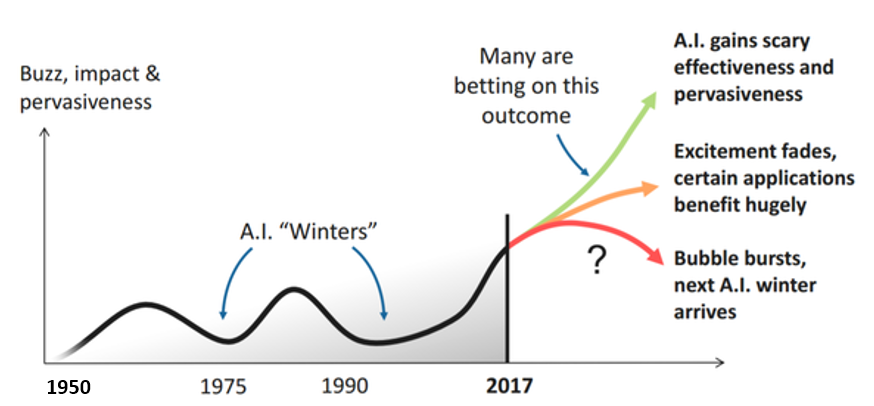The basics
Modern organizations understand that Artificial Intelligence (AI) is critical to survival. The driver for AI can be a competitor or new customer demand.
However, not all organizations have the same understanding of what AI is. Furthermore, each organization is at a different stage of its digital transformation toward AI. There are many definitions or explanations for what AI is, and there is no single roadmap to success.
When asked to present on AI, I always find it difficult to gauge the audience’s knowledge level ahead of time. I am never sure what the audience knows or doesn’t know. AI is such a broad topic that I always start with a basic introduction to AI to level the audience.
AI blog series
To create an AI knowledge baseline, I am starting a series of blogs on AI based on my presentations, beginning with the basics of AI, and building up from here on. With the series, I hope to answer questions such as: What is the difference between AI, Machine Learning (ML), and Deep Learning (DL)? What is model accuracy? What are neural networks?
AI simplified
Over time many definitions for AI have been published. Usually, it references human intelligence and how AI is trying to simulate human intelligence. It might be true when we think of speech recognition or driving a car. However, modern AI has capabilities that humans can’t efficiently process.
For example, an AI recommender system recommends movies to watch based on previously viewed movies. There are many available movies to choose from, and a continuous stream of new movies is added daily. The task is too complex for a human as it would take a significant amount of time to analyze and recommend movies, let alone keep up with the continuous stream of new movies.
AI is more efficient with data (movies in our example) as it can analyze large amounts of data and return insights we might have missed as humans. In fact, the more data AI can analyze, the greater the chance of providing valuable insights.
Definition
The AI definition I provide when asked is:
“AI attempts to solve problems by analyzing large quantities of data and creating a model to predict future outcomes.”
Data-Centric
Modern AI is data-centric as opposed to rule-based in earlier iterations of AI. The data-centric approach has more significant potential as it can extract value from any given “data.” On the other hand, in a rule-based environment, the system is bound to the limitations of the given “rules.”
AI is continuous learning
AI is about learning from the past … and the future. Analyzing past data gives us a baseline model, while the data resulting from using the model contributes to improving the model. The creation of this feedback mechanism is what makes the data-centric approach so powerful. AI never stops learning and does learn from its mistakes.
Humans still rule
AI is a tool that should augment human intelligence, not replace humans. Of course, we could debate that AI doesn’t have the capabilities to replace humans, but that is a topic for a different blog.
AI democratization
AI is everywhere and here to stay. The democratization of AI means that the use of AI is not limited to niche use cases but has found a broader audience. As a result, people can feel the effect of AI in all aspects of life, such as religion, finances, and personal. However, concerns of bias in AI models need to be addressed and monitored. I recently was a co-host of a video podcast on this topic, and can be found here for more information.
AI – Winter(s)
The first wave of optimism came in the 1950s (See figure 1) with the introduction of AI and part of the technological revolution. Then, in the 1960s, AI booked some successes and led to additional investments. 
Figure – Quora.com, Evolution of AI, AI Winter
The first AI Winter
However, the bar was set too high due to high expectations, and the lack of progress and success slowed down the revolution. Eventually, AI reached a winter period with limited interest in further exploring AI and reduced investments.
From the mid-1970s, the advances in computing technology (Moore’s Law) and the introduction of software development and methodologies opened opportunities once again. Hardware takes considerable effort to bring to market. Replacing some of the functionality provided by hardware with software increased the flexibility of AI solutions. The rule-based development approach became a forceful driver for AI.
The second AI Winter
However, this wasn’t enough to keep momentum, and interest and investment faded over time. As a result, we entered another AI winter in the 1990s.
What’s next?
We have since then experienced a revival of AI. Will it last? What makes it different this time?
I believe the main differences are:
- The data-centric approach is superior to the rule-based method.
- Easy and cheap access to quality data.
- Access to hardware is not a challenge anymore.
- AI software frameworks are openly available and developed by a thriving open-source community.
- A healthy competition results in continuous hardware and software innovations.
- AI is not a niche play anymore
- AI is causing organizations to transform their business along the way, causing a cultural change.
- AI is a must-have driven by competition.
Additional source
“Around the I.T. Block” podcast #32, “What is AI, ML and DL?” a podcast with Calvin Zito from HPE and guest Frederic Van Haren.
What’s next?
Next up in the series are the differences between AI, ML, and DL.
Stay tuned
I am a co-host of “Utilizing AI,” a podcast focusing on AI in the Enterprise. We discuss the above topics and many others at length in the podcasts. To learn more about the podcasts, follow this link.



